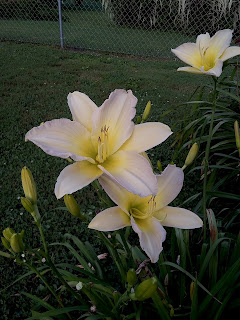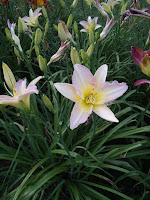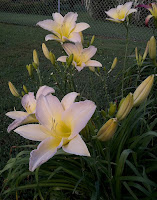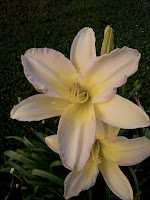Cultivar Name: Glacial Substance
Seedling Number: PRSE 9
Bloom Diameter: 5”
Scape Height: 41”
Branches: 3
Bud Count: 12
Bloom Season: LATE
Rebloom: Yes
Color/Description: Icy cold lavender above chartreuse to yellow throat with extremely thick petal substance.
Ploidy: Dip
Bloom Habit: ext
Foliage: SEV
Fragrance: Unk
Pod Parent: Phoenician Royalty
Pollen Parent: Substantial Evidence
Year Bred: 2013
Rust Resistance: A+/3 years
Fertile: Pollen is strong, pods are difficult to impossible.
For a complete list of my available daylilies and pricing, click here.
Comments: Glacial Substance is another of those oddities deriving from Substantial Evidence. Bred in 2013 and germinated in 2014, Glacial Substance goes back to the early days of my program and went through three years of my five-year rust resistance screening program. I didn't pay much attention to this seedling for a couple of years after it first flowered. I kept it those years because the plant was extremely rust resistant. In 2017 I came to realize that this wasn't just special because of the rust resistance, but also because of the extreme substance and resistance to sun and rain. I am not exaggerating when I say that Glacial Substance has the thickest and strongest petal I have ever seen on a diploid. I haven't seen them all, but of the registered cultivars and seedlings I have grown, this is the absolute thickest substance I have ever seen at this ploidy, and it rivals most tetraploids for substance, with better substance than a good few. The durability is also quite outstanding. With the images below is a photo from the day I realized that this seedling was something special. The name, Glacial Substance, is a nod to the parent, Substantial Evidence, and to the intense, plastic-like, thick substance of the petals.
If the high rust resistance and the extreme substance weren't enough, Glacial Substance gets intense, clear, icy-lavender coloring and robust scapes from the pod parent, Phoenician Royalty. The scape height can vary, with plants grown in partial shade often producing taller scapes. I have seen scapes as tall as 48" and as short as 34" in different years, or after the cultivar has been divided and moved. Like most daylilies, a more mature clump will tend to show the unique traits of the cultivar more clearly. Glacial Substance is a late season bloomer, starting to flower when others are winding down or completely finished. Much of the breeding I did with it was onto rebloom scapes of earlier flowering cultivars, mainly because I didn't have many late options to breed it to. The fertility of the pollen is very good. I produced numerous batches of seedlings with diploids with the pollen over several years. It passes that intense substance to some of the seedlings. Pods are extremely difficult and I have only ever gotten a few, but someone will probably have it be their best pod mother. That never fails. :-)
Because of its robust scape and the extreme flower substance that Glacial Substance shows, I wondered if it were perhaps a triploid or tetraploid. I tried it extensively for several years in a row on all the rebloom from most of my tetraploids and never got any seeds from any of the attempts. I almost always got seeds from its pollen on diploids though, so I suspect it is just a robust diploid with exceptional flower substance. The plant remains semi-evergreen in warm-winter conditions, but will go dormant in extreme cold. I have seen both behaviors here, and it just depends on what our winter is like. I suspect it will grow well in a fairly wide range of climates, as both parents can grow successfully in a good many zones, generally at least zone 8 to zone 4. I think Glacial Substance has tremendous breeding potential for several traits, including rust resistance, late season flowering, great color clarity, and extreme petal thickness, substance and durability. I think it would work very well in both northern and southern breeding programs.



%20X%20SE%2013.jpg)
XSE%201111.jpg)

XSE%2011.jpg)

XSE%2011111.jpg)



